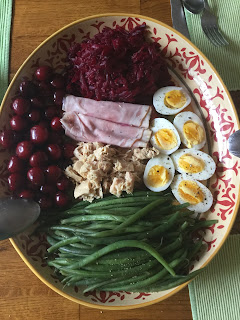The Composed Salad
What’s the difference between a salad and a composed salad? From the French “salade composée,” a composed salad is simply salad arranged on a plate rather than tossed in a bowl.
But for the American cook in summer, it is much more than that: a back-pocket lunch or dinner that can be endlessly reinvented and served to many people at any time. It shows off the intense, irresistible vegetables, herbs and fruits of the season — but can also have rich components like cheese, eggs, toasted nuts and smoked fish or meat. With a loaf of (preferably grilled) bread, it is a meal in itself.
Like the V.I.P. pass at a music festival that gets you a folding chair and access to a charging station, a composed salad provides a little extra organization and luxury, but still holds the wild spirit of summer.
That’s because it can contain almost anything the cook wants to arrange, roll, roast, poach, bake or grill, from thin shavings of fennel and whole kernels of local corn to dollops of ricotta and shards of country ham. Tossed together, the result would be sloppy and monotonous. A bit of order makes it satisfying and elegant.
A controlled riot is the goal, which can be achieved by choosing one or two elements from each category below. Lay them out on one vast platter (the prettier choice) or on individual plates (faster). Ingredients can be arranged in loose stripes or wedges, or be artfully distributed around the platter.




Comments
Post a Comment